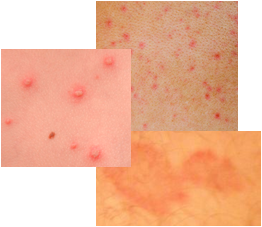Diaper Rash
Visit this
PICTURES OF RASHES PAGE
A diaper rash is a skin condition that is common in babies. It is also a skin problem that may affect adults (usually but not always the elderly) that have to wear a diaper due to bladder control problems or incontinence. Anyone that has to wear a diaper will likely develop this rash at some point during the diaper wearing period.
This type of skin rash can be quite uncomfortable and painful, but fortunately is not dangerous and with proper treatment no complications will occur. However, vigilance is still required because without proper treatment a skin infection can develop. This is usually caused by yeast or bacteria that are residing on the skin.
A yeast diaper skin rash is the term usually given to a diaper rash that gets infected. Another term used to refer to this skin condition is Candida diaper rash. This rash causes the skin to be irritated. If it is damaged then yeast (fungus) or bacteria can penetrate the protective barrier of the skin and cause an infection. When this occurs, the diaper rash can become significantly worse.
The source of the yeast may be from the surface of the skin or from the intestines via stool. The fact that the covered diaper area of the skin is dark, warm, and moist only accelerates or promotes the development of the fungal or yeast infection. The infection usually starts in the creased areas or fold areas of the skin and the genitals, thighs, and buttocks can be affected.

The use of antibiotics can promote the Candida rash because antibiotics kill bacteria. On one hand this is good because you want the antibiotics to kill the bad bacteria that are causing the problem being treated. Unfortunately this medication also kills some good bacteria which causes a greater risk of the fungal problem developing. The yeast starts growing out of control because there are no bacteria to keep the yeast level controlled.
The yeast diaper skin rash is characterized by red raised patches of skin that have sharp borders and slightly raised red dots that appear around the skin creases or skin folds and are away from the main diaper rash irritation area. These dots can spread further away from the diaper rash site to other parts of the torso.
If regular treatments and prevention techniques do not eliminate the rash after a few days, then a Candida rash may be the problem and this requires treating the infection with an anti fungal cream.
Diaper Rash Symptoms
A diaper skin rash is essentially contact dermatitis (sometimes it is called diaper dermatitis) or a skin irritation or inflammation and is generally characterized by the appearance of bright red skin in the groin or buttock region of the affected individual. Basically, the nappy rash can occur anywhere in the skin region that is covered by a diaper. More nappy rash symptom details can be found at the symptoms page.
There are various causes for a diaper skin rash in general.
Friction as a Cause
Friction caused by a diaper constantly rubbing against the skin can irritate the skin. This usually occurs if the diaper does not fit well or is not properly fastened.
Chemical Dermatitis
Another nappy rash cause is due to chemical dermatitis. If urine or stool is left in contact with the skin then this can cause the skin to become red and irritated. How much contact time is necessary to cause irritation is variable since it depends on the skin sensitivity of the individual. The skin of a baby tends to be more sensitive than the skin of an adult and therefore less resistant to chemical dermatitis. If the individual has other skin problems such as eczema, then often skin sensitivity to other skin rashes is heightened. The rash problem persists or gets worse as additional contact is made between the offending substances and the irritated skin. If the contact with urine, stool, or mixture of both happens often, the skin may become extra sensitive to these elements and future diaper rashes might develop very easily.
Chemical dermatitis leading to a nappy rash can also occur due to detergent residue that may be left in cloth diapers, the use of scented fabric softeners, the use of bleach when laundering cloth diapers, a skin reaction to the materials used in non-cloth diapers such as fragrances, disposable baby wipes which often contain a host of chemical products, or various creams and lotions that may be used on the skin.
When choosing products to use on a baby's skin, it is important to take note of the chemical ingredients and ensure that those ingredients will not harm the baby's skin. The less chemicals the better for rash prevention and overall healthy skin.
Heat and Moisture Diaper Rash Causes
Trapped heat and moisture in close contact with the skin accelerate the development of a nappy rash and therefore, the build-up of these elements should be avoided as much as possible. This means the use of plastic cover pants that do not breathe or in other words allow heat and moisture to escape, should be avoided.
Mother's Diet as a Cause
A diaper skin rash may also be caused by what the mother eats when breast feeding. In fact this often occurs after the child is introduced to solid food.
Antibiotics
Taking antibiotics is another common cause of a severe diaper rash. Antibiotics as a side-effect for many can cause diarrhea which initiates or makes the rash worse. Antibiotics also destroy good bacteria which can contribute to the development of a severe version of this rash.
Diaper or Nappy Rash Treatments
There are several effective treatments or remedies that can be used to alleviate this type of rash. Many of these treatments are quite simple to use and do not require a prescription. Many diaper skin rash home remedies exist as well and have been used effectively for many years.
Of course, like many other skin rashes or skin conditions, effective prevention techniques can be used to stop a diaper rash from forming or preventing it from reoccurring often.
